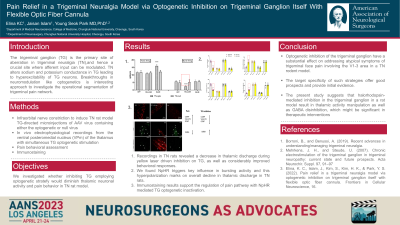Pain Relief in a Trigeminal Neuralgia Model via Optogenetic Inhibition on Trigeminal Ganglion Itself With Flexible Optic Fiber Cannula
Pain Relief in a Trigeminal Neuralgia Model via Optogenetic Inhibition on Trigeminal Ganglion Itself with Flexible Optic Fiber Cannula
Friday, April 21, 2023

Has Audio

Young Seok Park (he/him/his)
Prof
Chungbuk National univ
Cheongju-si, Republic of Korea
ePoster Presenter(s)
Introduction: The trigeminal ganglion (TG) is the primary site of aberration in trigeminal neuralgia (TN), and hence a crucial site where afferent input can be modulated. Here, we postulated that inhibiting TG via optogenetics using flexible optic cannula would diminish brainstem trigeminal nucleus caudalis (TNC) neuronal activity and pain behavior in TN rat model.
Methods: Infraorbital nerve constriction was employed to induce TN in female Sprague-Dawley rats, while naive and sham rats served as controls. TG-directed microinjections of AAV virus containing either the optogenetic or null vector were delivered to rats in each group. In vivo electrophysiological responses were obtained from the ventral posteromedial nucleus (VPm) of the thalamus with simultaneous TG optogenetic stimulation using flexible optic cannula as well the effects on behavioral responses were investigated.
Results: Recordings in TN rats revealed a decrease in burst firing activity during yellow laser driven inhibition on TG, as well as considerably improved behavioral responses. In contrast, we noticed persistent hypersensitivity and increased tonic firing with blue laser stimulation which indicates that TG inhibition can synchronize trigeminal pain signal transmission in a TN animal model.
Conclusion : The potential of an optogenetic approach in TG itself with flexible optic fiber to directly disrupt the trigeminal pain circuitry delivers fundamental underpinnings toward its prospective as a trigeminal neuralgia management.
Methods: Infraorbital nerve constriction was employed to induce TN in female Sprague-Dawley rats, while naive and sham rats served as controls. TG-directed microinjections of AAV virus containing either the optogenetic or null vector were delivered to rats in each group. In vivo electrophysiological responses were obtained from the ventral posteromedial nucleus (VPm) of the thalamus with simultaneous TG optogenetic stimulation using flexible optic cannula as well the effects on behavioral responses were investigated.
Results: Recordings in TN rats revealed a decrease in burst firing activity during yellow laser driven inhibition on TG, as well as considerably improved behavioral responses. In contrast, we noticed persistent hypersensitivity and increased tonic firing with blue laser stimulation which indicates that TG inhibition can synchronize trigeminal pain signal transmission in a TN animal model.
Conclusion : The potential of an optogenetic approach in TG itself with flexible optic fiber to directly disrupt the trigeminal pain circuitry delivers fundamental underpinnings toward its prospective as a trigeminal neuralgia management.
